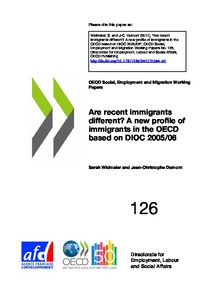Are recent immigrants different? A new profile of immigrants in the OECD based on DIOC 2005/06
"Increasing international migration and changing immigrant populations in OECD countries make international comparable data on migrant populations essential. These data should be updated regularly to capture a detailed picture of migrant populations. This document presents the first results of...
| Main Authors: | , |
|---|---|
| Institution: | ETUI-European Trade Union Institute |
| Format: | TEXT |
| Language: | English |
| Published: |
Paris
2011
OECD |
| Subjects: | |
| Online Access: | https://www.labourline.org/KENTIKA-19136754124919549369-are-recent-immigrants-differen.htm |
| Summary: | "Increasing international migration and changing immigrant populations in OECD countries make international comparable data on migrant populations essential. These data should be updated regularly to capture a detailed picture of migrant populations. This document presents the first results of the update of the Database on Immigrants in OECD Countries (DIOC) for the years 2005/06. It describes immigrant and emigrant populations by socio-demographic characteristics and labour market outcomes in the OECD, as well as updated "brain drain" figures.
In 2005/06, 10.8% of the population in the OECD was foreign-born, representing 91 million persons. Latin American and African migrant populations increased by more than 30% between 2000 and 2005/06, slightly more than that of Asian migrants (27%). Labour market outcomes of immigrants vary by region and country of origin, but they improved significantly since 2000. In many OECD countries, low-educated foreign-born fare better on the labour market than their native-born counterparts, but high-educated migrants tend to have lower employment rates and higher unemployment rates than their native-born counterparts." |
|---|---|
| Physical Description: | 70 p. Digital |

